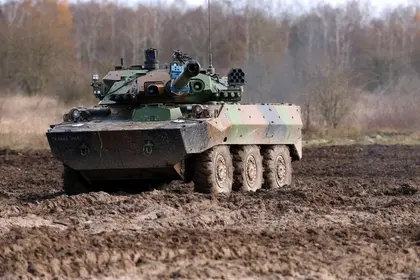France’s announcement in January that it was to send AMX-10 RC “tanks” to Ukraine encouraged Germany to agree to provide its own Leopard main battle tanks and free other users of that world-class machine to donate theirs. At the time many observers questioned if the AMX was, in fact, a tank at all. Recent events on the battlefields of Ukraine confirm those concerns.
A Ukrainian battalion commander from the 37th Marine Brigade, identified only by his call sign “Spartanets,” has said that the French-supplied AMX-10 RC combat vehicles are unsuitable for use as attack vehicles on the frontline.
- Find the most current war in ukraine update in the Kyiv Post’s daily news reports published today.
JOIN US ON TELEGRAM
Follow our coverage of the war on the @Kyivpost_official.
He cited an incident when that type of vehicle was destroyed and its four-man crew killed when fragments from a [152 mm] artillery round penetrated its thin, aluminum armor and caused its onboard ammunition to detonate.
Features of the AMX-10 RC
The AMX-10RC was developed in the early 1970s by Giat and Renault, as a reconnaissance vehicle, promoted on the strength of its firepower, protection and high mobility. It has since received a number of upgrades to extend its service life to 2020 and beyond.
It is a four-man, 6x6-wheeled vehicle. The vehicle is variously referred to as a light tank, a wheeled tank, military purists call it an armored reconnaissance vehicle or even, because it carries a hefty 105 mm tank gun and a modern fire control system, as a tank destroyer. Oleksii Reznikov, the Ukrainian minister of defense, after test-driving one of the vehicles called it a “sniper rifle on... fast wheels.”

Putin Hints Precondition for Peace Talks: Neutered Ukraine
The truth is that its role and capabilities straddle all those functions and as with most things, to use a well-known figure of speech: “A jack of all trades is master of none.”
Its great strengths lie in its main armament and its mobility. Its all-wheel drive allows good speed both on roads and off-road and it is fully amphibious with a range of 1,000 km.
Its big weakness lies in the level of protection offered by its aluminum armor which only gives protection from small arms fire and shell splinters, the main reason it can’t really be considered to be a tank.
Spartanets’ comment supported this overall assessment: “The guns are good; the observation devices are very good. But unfortunately, there is thin armor and it’s impractical to use them in the front line [attack].”
The first AMX-10 RCs were delivered to the Ukrainian naval infantry [marines] in March, following operator training at the French armored school in Saumur.
The Ukrainian commander also had a view on this aspect of their use. He said that while undergoing a month’s training on the vehicle in France had made them familiar with the technical operation, maintenance and repair of the vehicle this was not long enough to fully master its tactical use. His troops are having to learn about their strengths and weaknesses and how to use them tactically, in combat, the hard way.
It’s believed that France provided 30 AMX 10 RC vehicles to Ukraine, but the exact number hasn’t been declared. The open-source intelligence website Oryx, which maintains statistics on both Russian and Ukrainian equipment losses, based on battlefield imagery, has identified the loss of three AMX-10 RC vehicles since the start of the summer offensive.
It’s probable that because of its relatively light armor the AMX-10 RC Ukraine will use them primarily in the fire support role for attacks by main battle tanks and other better-protected armored vehicles in the future.
Having seen the effect of Russian artillery and mines on a number of vehicles, Spartanets was particularly impressed by the Mine-Resistant Ambush Protected (MRAP) vehicles such as the US Oshkosh and the UK’s Husky vehicles. While they lacked the firepower of the AMX-10, their survivability and the protection they provided to their crews was impressive.
Describing these vehicles, in typical military understatement, he said “in terms of protection, the vehicle is very cool.” He recounted instances where direct hits by rocket-propelled grenades (RPG) were resisted, “near misses” by artillery shells only caused shrapnel damage to the vehicle hood and even, after running over an anti-tank mine (AT mine), only lost a wheel with the crew compartment escaping unscathed.
In contrast, when describing the effects on Soviet-era infantry fighting vehicles, such as the BMP, after driving over an AT mine, he said with very little irony: “it is very sad for the crew and the vehicle,” he added.
The recently formed 37th brigade is directly involved as part of Ukraine’s current counter-offensive action on the Russian front line in the eastern sector. The battalion commander said his unit had taken a direct part in fighting around Blahodatne, a village that was recently retaken by Ukrainian forces.
You can also highlight the text and press Ctrl + Enter










